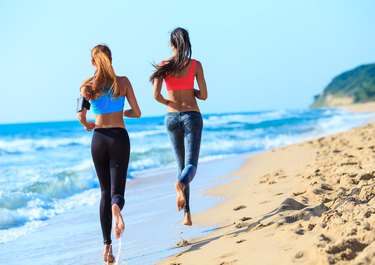
Depending on the type of barefoot exercise one chooses, skipping sneakers, in favor of working out barefoot can be beneficial for your feet and ankles. Going barefoot can strengthen muscles, enhance stability and improving proprioception for better balance.
Tip
The highly sensitive receptors of your feet can become dulled when supported by heavy shoes. Doing barefoot exercises may help enhance sensory stimulation and build stronger, stabler feet and ankles.
Video of the Day
The Benefits of Going Barefoot
Barefoot exercises and stretches done during activities such as yoga, Pilates, barre, Zumba and dance classes can improve the flexibility of, and strengthen, the muscles in your feet and ankles. The nerves on the bottom of your feet are very sensitive, but those same receptors are deprived of sensory stimulation when shoes are worn, leading to a potential weakening of the muscles in the feet.
Video of the Day
Doing barefoot exercises and stretches strengthens your feet and ankle muscles, improving their overall flexibility, dexterity and reactivity, according to Harvard Health. These barefoot activities also help improve stability in the ligaments that support your ankles and feet.
Being barefoot allows for better control over the position of your foot as it strikes the ground, improving balance, proprioception and body awareness. This, in turn, leads to improved mechanics and alignment in your knees, hips and core, which can prevent or reduce low back and other joint pain.
Reduced Running Impact on Joints
While barefoot running may come with some risks, barefoot runners may risk less excessive force on the joints than runners wearing conventional running shoes, according to the Mayo Clinic. Barefoot runners veer toward being "midfoot strikers" which reduces the impact of running on the soft tissue and lower extremity joints.
Barefoot running may also contribute to fewer sprains, shin splints and occurrences of plantar fasciitis, an inflammation of connective tissue on the bottom of the foot. Additionally, running without sneakers, or with lightweight shoes that simulate barefoot running, can increase running speed.
The American Council on Exercise says that barefoot runners typically run more lightly, landing closer to the balls of the feel, which then causes less pounding and impact on the joints compared to traditional heel strike runners. In addition, running barefoot on a beach adds resistance that forces your muscles to work harder, for a more challenging workout.
Read more: How to Strengthen Your Feet for Running
When to Go Barefoot
While going barefoot is the standard for certain exercises such as water sports, dance, yoga, barre and Pilates, other activities, including weight lifting and cross-training in a group fitness setting, are better suited to the protection and stability offered by wearing a sneaker.
Harvard Health recommends adding foot flexibility and resistance exercises into your daily routine. Some can even be done while sitting at a desk or standing barefoot with a wall nearby for stability. Always be sure to stretch the muscles of your feet prior to any physical activity, especially those that are high impact, such as aerobics, to best prevent your feet and ankles from suddenly bearing the brunt of added force.
Those with conditions such as diabetes, arthritis or structural foot problems should check in with their physician prior to doing any sort of barefoot exercise.
- American Council on Exercise: Like Barefoot, Only Better?
- Mayo Clinic: Barefoot Running Shoes
- Harvard Health: Exercises for Healthy Feet
- American College of Foot and Ankle Surgeons: Going Barefoot? Beware!
- University of Rochester Medical Center: Health Encyclopedia - Summer Foot Care for Diabetes
- American Academy of Orthopaedic Surgeons: Foot and Ankle Conditioning Program